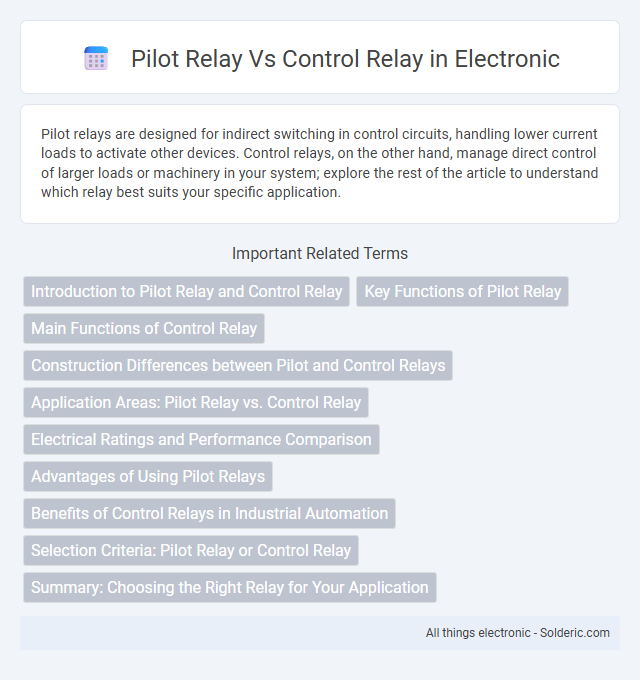Pilot relays are designed for indirect switching in control circuits, handling lower current loads to activate other devices. Control relays, on the other hand, manage direct control of larger loads or machinery in your system; explore the rest of the article to understand which relay best suits your specific application.
Comparison Table
| Feature | Pilot Relay | Control Relay |
|---|---|---|
| Primary Function | Controls other relays or devices remotely | Directly controls electrical circuits or loads |
| Application | Used in complex control systems and automation | Used for switching electrical loads and circuits |
| Contact Rating | Generally low power, designed for signal switching | Higher power ratings, switches larger currents |
| Coil Voltage | Typically low voltage for signaling | Varies widely depending on load requirements |
| Size | Smaller and compact for integration | Varies; can be larger for heavy-duty control |
| Use Case Example | Triggering multiple relays in a control panel | Switching motors or lighting circuits |
Introduction to Pilot Relay and Control Relay
Pilot relays are specialized electromagnetic devices used to control larger loads indirectly by receiving low-power control signals, ensuring safety and system efficiency. Control relays operate as switches within electrical circuits, enabling automation by opening or closing contacts based on input signals. Understanding the distinction between pilot and control relays helps you optimize electrical control systems for reliability and performance.
Key Functions of Pilot Relay
Pilot relays serve as intermediary devices that amplify weak control signals to safely operate larger, high-current control relays or contactors in electrical circuits. They provide electrical isolation and reduce the load on control switches, enhancing system reliability and operator safety. Pilot relays are crucial in automation systems for precise control, signaling, and protection functions without directly handling the main power load.
Main Functions of Control Relay
Control relays function primarily to manage and direct electrical circuits by opening or closing contacts in response to input signals, enabling automation and protection in control systems. They facilitate the switching of low-power control signals while isolating and controlling higher power circuits, ensuring system safety and efficiency. Your control relay ensures precise operation in industrial machinery and process controls by modulating circuit connectivity based on specific control logic.
Construction Differences between Pilot and Control Relays
Pilot relays typically feature compact construction with a single or dual coil and fewer contacts designed for low power control circuits, while control relays have more robust designs with multiple contacts and higher current ratings suitable for direct control of equipment. The coil voltage and contact arrangement in pilot relays are optimized for signal transmission and minimal power consumption, whereas control relays are constructed to handle larger loads and provide reliable switching in industrial applications. Material quality and insulation in control relays are generally superior to withstand harsher operating conditions compared to the simpler build of pilot relays focused on signal-level operations.
Application Areas: Pilot Relay vs. Control Relay
Pilot relays excel in signaling and interlocking applications within industrial automation systems, ensuring precise control of circuit operations and protection mechanisms. Control relays are widely used for switching and controlling power circuits in machinery, HVAC systems, and motor starters, providing reliable operation under varying electrical loads. Understanding your system's specific requirements helps determine whether a pilot relay or a control relay best suits your application needs.
Electrical Ratings and Performance Comparison
Pilot relays typically have lower electrical ratings, designed for control circuit switching with currents ranging from 1 to 10 amps, while control relays handle higher power loads, often exceeding 20 amps for switching main power circuits. Pilot relays provide faster response times and increased reliability in low-current applications, ensuring precise control without overloading sensitive components. Your selection should consider the performance requirements, as control relays offer robust switching capabilities for heavy loads, whereas pilot relays optimize control circuit efficiency and safety.
Advantages of Using Pilot Relays
Pilot relays offer significant advantages in electrical control systems, including faster response times and improved reliability due to their lower coil power requirements compared to control relays. Their compact design enables better space utilization in control panels, while their ability to handle higher switching frequencies reduces wear and extends the lifespan of the relay. You benefit from increased operational efficiency and enhanced system protection when incorporating pilot relays into your electrical circuits.
Benefits of Control Relays in Industrial Automation
Control relays in industrial automation enhance system reliability by providing precise switching and isolation between control circuits and high-power loads. Your operations benefit from improved safety and flexibility, as control relays allow easy integration with programmable logic controllers (PLCs) and other automation devices. These relays also reduce electrical noise and extend equipment life by preventing direct exposure to heavy currents.
Selection Criteria: Pilot Relay or Control Relay
Selection criteria for pilot relays emphasize low voltage control with fast switching capabilities, suitable for signaling and interlocking in automation systems. Control relays are selected based on their ability to handle higher voltage and current loads for switching power circuits, ensuring robust operation in industrial equipment. Key factors include load type, coil voltage, switching speed, and application environment to determine the appropriate relay type.
Summary: Choosing the Right Relay for Your Application
Selecting the right relay depends on the specific application requirements: pilot relays are designed for signaling and controlling other relays with low power consumption, while control relays handle direct load switching and higher current loads. Pilot relays offer fast response and minimal electrical wear, making them ideal for complex control circuits, whereas control relays provide robust operation for switching motors, heaters, and lighting. Evaluating parameters such as coil voltage, contact configuration, and load capacity ensures optimal relay performance and longevity in industrial or automation systems.
pilot relay vs control relay Infographic

 solderic.com
solderic.com